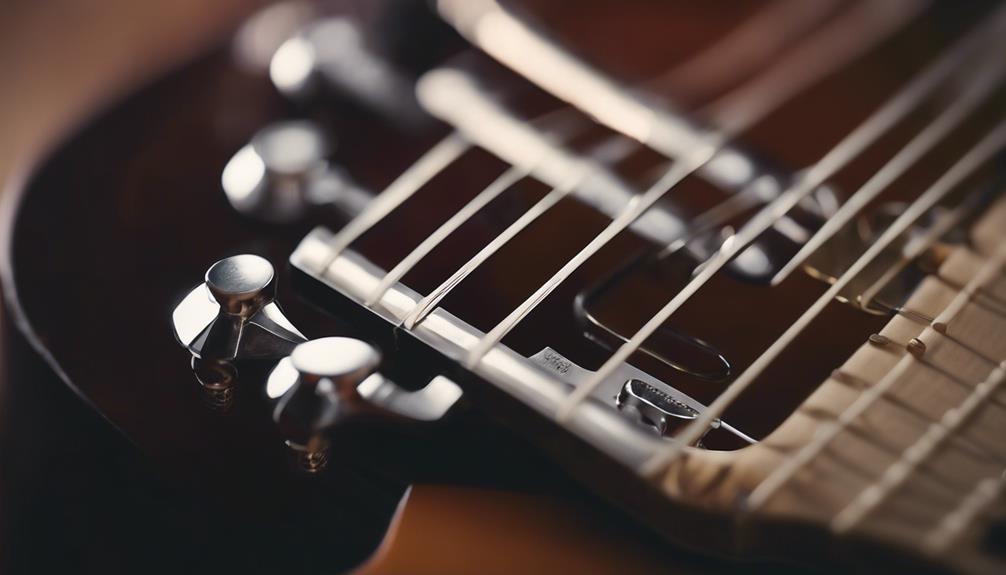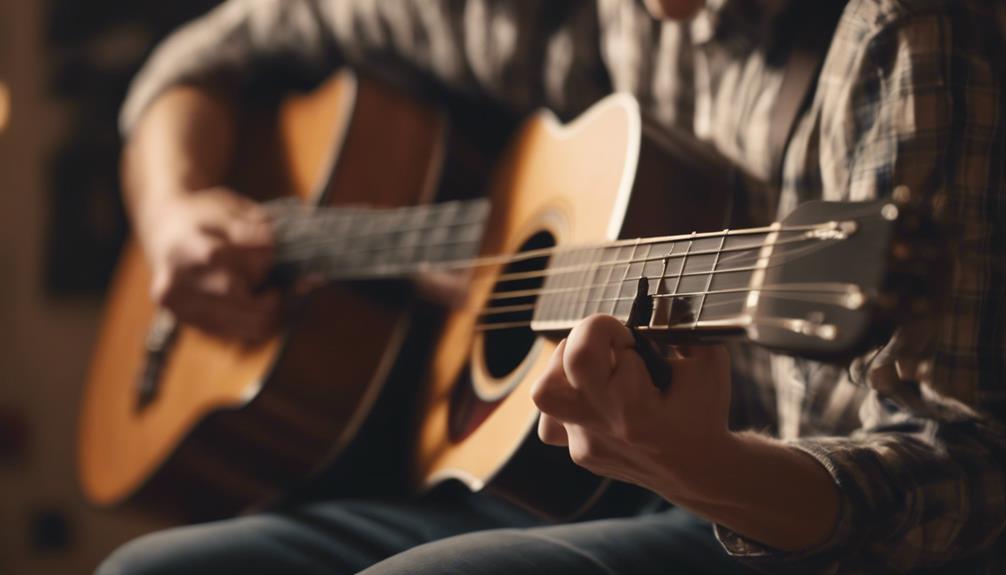When you’re starting to play the guitar, it’s essential to first familiarize yourself with its basic components, such as the headstock, neck, and strings. By understanding these parts, you’ll have a solid foundation to build on.
Next, you’ll need to master proper holding techniques to guarantee comfort and prevent injury. But before you even strum your first chord, there’s one more fundamental aspect you need to grasp.
This step will set the stage for everything you’re about to learn, making sure you progress smoothly and efficiently. Curious about what it is to play the guitar like a pro? Let’s explore further.
TL-DR
- Learn and practice basic chords like C Major, G Major, and D Major for foundational skills.
- Hold the guitar properly with the body curve on your leg and maintain a straight back.
- Use a metronome to develop rhythm and timing for strumming patterns and chord changes.
- Practice basic strumming patterns, focusing on downstrokes and upstrokes for smooth, rhythmic playing.
- Maintain a consistent practice schedule of 15-30 minutes daily to build muscle memory and improve dexterity.
Understanding Guitar Components

When you’re learning to play guitar, it’s essential to understand the components that make up the instrument. Start with the headstock, where you’ll find the tuning pegs. These pegs adjust the tension of the strings, allowing you to achieve the correct pitch.
Moving down, you’ll encounter the neck, which features frets. These raised metal strips divide the fretboard into specific notes, helping you play different chords and melodies accurately.
Next, consider the strings themselves. Typically made of steel or nylon, they produce distinct tones and require different techniques to play. Steel strings are common in acoustic and electric guitars, providing a bright and powerful sound. Nylon strings, often found on classical guitars, deliver a softer and warmer tone.
The body of the guitar is also vital. It amplifies the sound and houses the sound hole, which enhances resonance and projection.
Finally, other important components include the bridge and pickups. The bridge helps transfer the vibration of the strings to the body, affecting tone and sustain. Pickups, found on electric guitars, convert string vibrations into electrical signals, influencing the guitar’s versatility and sound.
Understanding these components will enrich your playing experience.
Proper Holding Techniques
Now that you’re familiar with the guitar’s components, let’s focus on how to hold the guitar properly for best playing comfort and technique.
First, hold the guitar against your body with the curve of the body resting on your leg. This provides stability and comfort, crucial for longer practice sessions. Make sure to keep your back straight to prevent strain and maintain the guitar at a slight angle. This guarantees proper hand positioning and reduces unnecessary tension.
When it comes to supporting the guitar, use your non-fretting hand to hold the neck. This helps maintain control and minimizes wrist strain. An important aspect of hand positioning is placing your thumb behind the neck, directly opposite your fingers. This technique facilitates smoother chord changes and enhances your dexterity, making it easier to navigate the fretboard.
Finding a comfortable balance between holding the guitar securely and allowing for fluid movement is key. You don’t want to grip the guitar too tightly, as this can restrict your playing. Instead, aim for a relaxed, yet firm hold that enables you to move freely while maintaining control.
Basic Finger Numbering

Next, let’s talk about basic finger numbering, starting with your index finger as 1 and your pinky as 4.
This system makes it easier to follow chord diagrams and tablature. Focus on correct finger placement to guarantee smooth changes and accurate fretting.
Finger Numbering Basics
Understanding basic finger numbering is essential for any beginner looking to master guitar chords and finger placement. When you’re learning to play, knowing which finger to use for each note can make a significant difference.
The basic finger numbering system starts with your index finger as 1, your middle finger as 2, your ring finger as 3, and your pinky finger as 4. This system simplifies the process of reading chord diagrams and understanding where each finger should go.
By assigning numbers to your fingers, you’ll find it easier to:
- Follow chord diagrams accurately
- Move between chords smoothly
- Improve dexterity in your fretting hand
- Develop good playing habits from the start
Practicing finger numbering exercises is vital for building coordination and strength in your fingers. As you become more familiar with this system, you’ll notice that your ability to play different chords and switch between them improves significantly.
It’s all about muscle memory and consistency, which you’ll develop over time with regular practice.
Correct Finger Placement
To play guitar chords accurately, you need to place your fingers correctly on the fretboard. Proper finger placement is important for beginner guitarists to master chord changes and play complex melodies.
Start by understanding the basic finger numbering: your index finger is ‘1,’ middle finger ‘2,’ ring finger ‘3,’ and pinky finger ‘4.’ This numbering system helps you assign specific fingers to fret particular strings, ensuring you form chords efficiently and accurately.
Beginner guitarists should focus on consistent finger placement to improve dexterity and speed. Place your fingertips just behind the frets, pressing firmly but not excessively. Avoid letting your fingers touch adjacent strings, as this can mute the sound and lead to unclear notes.
Practicing this regularly will help develop muscle memory, making your chord adjustments smoother over time.
Learning Basic Chords
When learning to play guitar, start with easy beginner chords like C Major, D Major, G Major, and E Minor to build a solid foundation. These basic chords are essential for many songs and will help you get comfortable with finger placement and hand coordination. Use chord charts and diagrams to visualize where your fingers should go on the fretboard. This makes the learning process easier and more intuitive.
To improve your playing, focus on moving smoothly between these chords. This will enhance your overall sound and make your playing more enjoyable. Practicing these movements regularly will also build muscle memory, making it easier to tackle more complex chords later on.
Here are some tips to help you master basic chords:
- Practice daily: Consistency is key. Spend at least 15-20 minutes each day working on your chords.
- Use a metronome: This will help you keep a steady rhythm while switching between chords.
- Start slow: Play each chord slowly at first, then gradually increase your speed.
- Listen to songs: Identify songs that use these basic chords to see how they fit into actual music.
Understanding these fundamental chords is important as they form the backbone of many rhythm parts in songs.
Basic Strumming Patterns

Mastering basic strumming patterns is essential for developing rhythm and adding dynamics to your guitar playing. At the core of these patterns are downstrokes and upstrokes. Start with simple patterns like down, down-up, and up-down. These foundational movements will help you build a strong sense of timing and coordination.
When you practice, focus on your wrist movement. Keep it loose and let it guide the motion of your strumming. This will make your playing smoother and more natural. Consistency is key, so maintain a steady rhythm while practicing these patterns. Use a metronome if needed to keep time.
Varying your strumming patterns can significantly enhance your musicality. Different songs and styles require different strumming approaches. For instance, slower ballads might benefit from a gentle down-up pattern, while upbeat songs might need a more energetic down-down-up-down-up pattern.
First Simple Song
Now that you’ve got the hang of basic strumming patterns, it’s time to tackle your first simple song.
Start with a basic chord progression using chords like C Major, G Major, and D Major.
Focus on smooth changes and steady strumming to keep the rhythm consistent.
Basic Chord Progression
Have you ever wondered how to start playing your first song on the guitar? Learning basic chord progressions is a great way to get started.
To kick off, you’ll want to focus on mastering a few basic chords like C Major, G Major, and D Major. These chords are the building blocks for countless songs and will help you learn to play guitar more smoothly.
Here’s a simple way to practice:
- Start with C Major: Place your ring finger on the third fret of the A string, middle finger on the second fret of the D string, and index finger on the first fret of the B string.
- Move to G Major: Place your middle finger on the third fret of the low E string, index finger on the second fret of the A string, and ring finger on the third fret of the high E string.
- Finish with D Major: Place your index finger on the second fret of the G string, middle finger on the second fret of the high E string, and ring finger on the third fret of the B string.
Practice shifting smoothly between these chords to create a simple chord progression. You can combine them to play popular beginner songs like ‘Twist and Shout’ or ‘Bad Moon Rising.’
Mastering these basic chord progressions lays a solid foundation for more complex songs as you advance in your guitar journey.
Strumming Pattern Tips
With a few basic chords under your belt, let’s explore some easy strumming patterns to bring your first simple song to life. Start with a basic downstroke strumming pattern using open chords like G, C, and D. For beginners, focusing on downstroke strumming can help you establish a steady rhythm. Count 1-2-3-4 as you strum down on each beat to keep time.
Now, let’s add some variety. Once you’re comfortable with downstrokes, experiment by adding upstrokes in between. This creates a more dynamic strumming pattern and adds texture to your playing. For example, you can strum down on 1 and 3, and add upstrokes on 2 and 4. This pattern would sound like: down-up-down-up.
Remember, the key to smooth strumming is a relaxed wrist. Tension can lead to choppy, inconsistent playing. Focus on maintaining a consistent strumming motion so your shifts between chords are seamless.
To practice, use online resources or apps that let you play along with songs. This gives you a chance to try different strumming patterns and develop your skills. Keep experimenting, and soon you’ll find your groove in no time!
Regular Practice Schedule

Establishing a consistent practice schedule is essential for anyone serious about learning to play the guitar. Dedicating daily time slots to practicing will help you build muscle memory and improve your skills. Aim for at least 15-30 minutes of focused practice each day. This consistent effort will go a long way in enhancing your finger dexterity and making smooth chord shifts.
To make the most out of your practice sessions, break them down into specific goals. Here are some ideas to get you started:
- Learning new chords: Spend time mastering both common and complex chords.
- Strumming patterns: Work on different strumming techniques to add variety to your playing.
- Chord shifts: Practice moving between chords smoothly and quickly.
- Songs: Apply what you’ve learned by playing your favorite songs.
Utilize tools like metronomes or practice apps to track your progress and maintain a structured routine. These tools can help you stay on beat and make your practice sessions more effective.
Next up, learn how to read guitar tabs in this guide.
